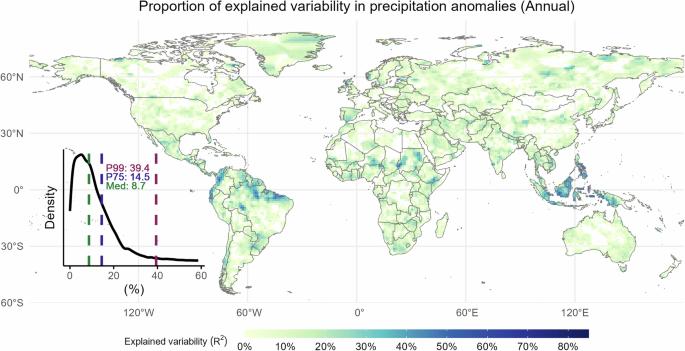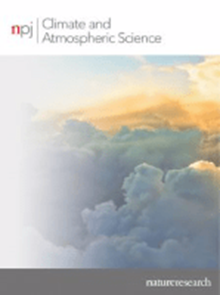气候模式如何很好地解释降水变率?
IF 8.4
1区 地球科学
Q1 METEOROLOGY & ATMOSPHERIC SCIENCES
引用次数: 0
摘要
气候变率的大尺度模态,如El Niño-Southern涛动、北大西洋涛动和印度洋偶极子,显示出与季节天气条件的显著区域相关性,并且是试图预测季节降水模式的气象机构的常规预测。在这里,我们将机器学习与更传统的方法一起使用,以量化大尺度变率模式可以解释多少降水变率,并了解这些模式非线性相互作用的程度。我们发现气候模式与降水之间的关系主要是非线性的。在某些地区和季节,气候模式可以解释高达80%的降水变率。然而,超过一半的地表变异性低于10%,只有1%的地表变异性高于50%。这一结果为限制对除少数选定地区和季节外的所有变率模式的可预测性的期望提供了明确的理由。本文章由计算机程序翻译,如有差异,请以英文原文为准。

How well do climate modes explain precipitation variability?
Large-scale modes of climate variability, such as the El Niño-Southern Oscillation, North Atlantic Oscillation, and Indian Ocean Dipole, show significant regional correlations with seasonal weather conditions, and are routinely forecast by meteorological agencies attempting to anticipate seasonal precipitation patterns. Here, we use machine learning together with more traditional approaches to quantify how much precipitation variability can be explained by large-scale modes of variability, and to understand the degree to which these modes interact non-linearly. We find that the relationship between climate modes and precipitation is predominantly non-linear. In some regions and seasons climate modes can explain up to 80% of precipitation variability. However, variability explained is below 10% for more than half of the land surface, and only 1% of the land shows values above 50%. This outcome provides a clear rationale to limit expectations of predictability from modes of variability in all but a few select regions and seasons.
求助全文
通过发布文献求助,成功后即可免费获取论文全文。
去求助
来源期刊

npj Climate and Atmospheric Science
Earth and Planetary Sciences-Atmospheric Science
CiteScore
8.80
自引率
3.30%
发文量
87
审稿时长
21 weeks
期刊介绍:
npj Climate and Atmospheric Science is an open-access journal encompassing the relevant physical, chemical, and biological aspects of atmospheric and climate science. The journal places particular emphasis on regional studies that unveil new insights into specific localities, including examinations of local atmospheric composition, such as aerosols.
The range of topics covered by the journal includes climate dynamics, climate variability, weather and climate prediction, climate change, ocean dynamics, weather extremes, air pollution, atmospheric chemistry (including aerosols), the hydrological cycle, and atmosphere–ocean and atmosphere–land interactions. The journal welcomes studies employing a diverse array of methods, including numerical and statistical modeling, the development and application of in situ observational techniques, remote sensing, and the development or evaluation of new reanalyses.
 求助内容:
求助内容: 应助结果提醒方式:
应助结果提醒方式:


